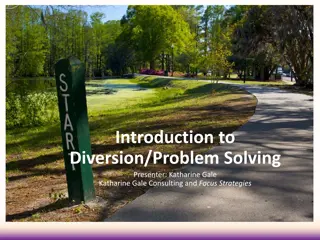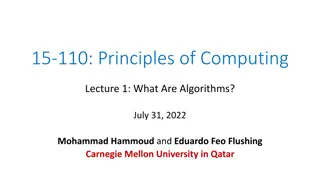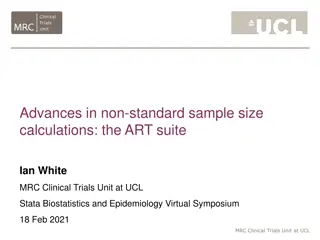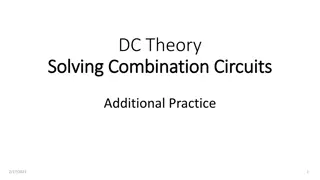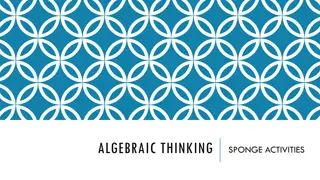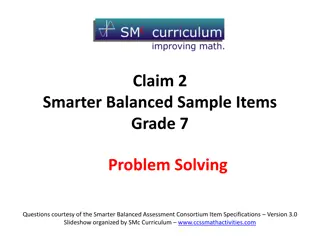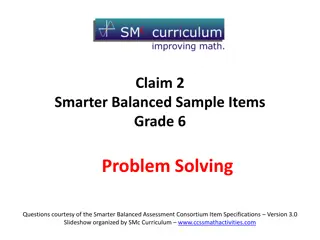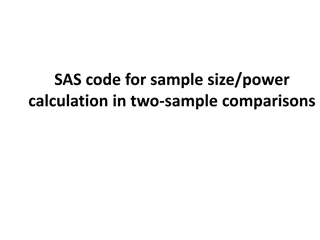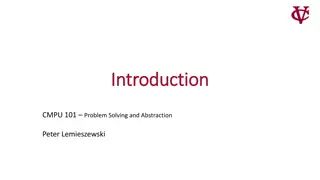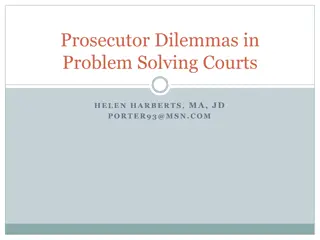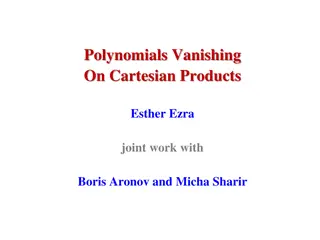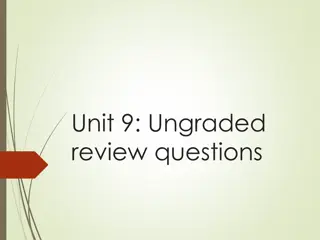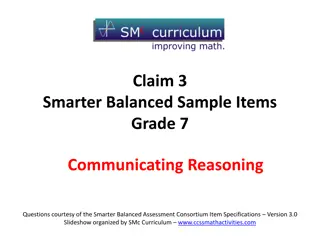High School Sample Problem-Solving Questions
Explore sample high school level problem-solving questions involving capacity, pricing, ingredient proportions, and geometry concepts. Test your math skills with real-world scenarios provided in the questions. Practice and improve your problem-solving abilities with these challenging exercises.
Download Presentation

Please find below an Image/Link to download the presentation.
The content on the website is provided AS IS for your information and personal use only. It may not be sold, licensed, or shared on other websites without obtaining consent from the author. Download presentation by click this link. If you encounter any issues during the download, it is possible that the publisher has removed the file from their server.
E N D
Presentation Transcript
High School Claim 2 Smarter Balanced Sample Items Problem Solving Questions courtesy of the Smarter Balanced Assessment Consortium Item Specifications Version 3.0 Slideshow organized by SMc Curriculum www.ccssmathactivities.com
#1 A company that makes rectangular baking pans labels each pan with the dimensions, in inches, and the capacity in quarts. A company employee needs to label a rectangular pan with dimensions 7 inches by 11 inches by 2 inches. 1 quart = 57.75 cubic inches What is the capacity, in quarts, of this pan? Round your answer to the nearest tenth.
#1 Answer Rubric: (1 point) The student correctly determines the capacity in quarts of the pan. Answer: accept 2.66 2.7
#2 A restaurant serves a vegetarian and a chicken lunch special each day. Each vegetarian special is the same price. Each chicken special is the same price. However, the price of the vegetarian special is different from the price of the chicken special. On Thursday, the restaurant collected $467 selling 21 vegetarian specials and 40 chicken specials. On Friday, the restaurant collected $484 selling 28 vegetarian specials and 36 chicken specials. Enter the cost, in dollars, of the vegetarian lunch special.
#2 Answer Rubric: (1 point) The student correctly determines the cost of the vegetarian special. Answer: 7
#3 A type of pasta is made of two ingredients, quinoa and corn. The pasta company is not disclosing the amount of each ingredient in the pasta, but we know that the quinoa in the pasta contains 16.2% protein, and the corn in the pasta contains 3.5% protein. Overall, each 57 gram serving of pasta contains a total of 4 grams of protein. How many grams of quinoa and how many grams of corn is in one serving of the pasta? Enter the number of grams of quinoa in the first response box. Enter the number of grams of corn in the second response box. Round each amount to the nearest gram. Quinoa: Corn:
#3 Answer Rubric: (2 points) The student enters the correct number of grams for quinoa and corn in the response boxes. (1 point) Either the student reverses the answers (confused between quinoa and corn) or only answers one correctly. Answer: Quinoa: 16; Corn: 41
#4 Melissa drew a right triangle. The length of the hypotenuse is 130 units. The perimeter is 14 + 130 units. Find the other two side lengths of Melissa s triangle. Enter one side length into each response box.
#4 Answer Rubric: (1 point) The student enters the correct side lengths in the response boxes. Answer: 3 and 11.
#5 Susan has an ear infection. Her doctor prescribes an antibiotic. The doctor tells Susan to take a 250-milligram dose of the antibiotic every 12 hours for the next 10 days. Susan finds out that 4% of the antibiotic is still in her body after 12 hours. Assume that each dose is exactly 250 milligrams and that Susan takes one dose every 12 hours. Part A How much of the antibiotic, in milligrams, is in Susan s body immediately after taking the 2nddose? Enter your answer in the first response box. Part B How much of the antibiotic, in milligrams, is in Susan s body immediately after taking the 10thdose? Enter your answer in the second response box.
#5 Answer Rubric: (2 points) The student enters the correct amount of antibiotic in Susan s body for Part A and B. (1 point) The student is able to determine the amount for Part A or Part B, but not both. Answers: Part A: 260 Part B: 260.4167 (An acceptable range for Part B is 260.4-260.417.)
#6 P(x) represents the cost that an online bookstore charges for shipping items and packaging material that together weigh x pounds. The packaging material weighs 1 pound. A competitor charges the same rate per pound but does not charge for the weight of the packaging material. However, the competitor does charge an additional $5 processing fee for each shipment. Which expression represents the cost of shipping x pounds with the competitor? A. P(x + 5) + 1 B. P(x + 5) 1 C. P(x + 1) + 5 D. P(x 1) + 5
#6 Answer Rubric: (1 point) The student selects the correct answer choice. Answer: D
#7 Two water tanks are shown. Tank A is a rectangular prism and Tank B is a cylinder. The tanks are not drawn to scale. Tank A is filled with water to the 10-meter mark. Click Tank A to change the water level. The volume of water that leaves Tank A is transferred to Tank B, and then the height of the water in Tank B is shown. Find the radius of Tank B, rounded to the nearest meter. Enter your answer in the response box.
#7 Answer Rubric: (1 point) The student enters the correct radius in the response box. Answer: 5
#8 A circle with center (6, 7) includes the point (1, 4). A second circle also include the point (1, 4), and contains the same area but has a different center. Enter the ordered pair that corresponds to the center of the second choice. ( , )
#8 Answer Rubric: (1 point) The student correctly enters the ordered pair in the response box. Answer: (-4, 1)
#9 The scatterplot shows the weight and gas mileage for 31 cars. Part A: Use the Add Arrow tool to create a line of best fit on the scatterplot. Part B: What is the meaning of the slope on the line of best fit in terms of the situation? A. For every additional kilogram of mass, the gas mileage is predicted to increase 0.013 miles per gallon. B. For every additional kilogram of mass, the gas mileage is predicted to decrease 0.013 miles per gallon. C. For every additional kilogram of mass, the gas mileage is predicted to increase 3 miles per gallon. D. For every additional kilogram of mass, the gas mileage is predicted to decrease 3 miles per gallon.
#9 Answer Rubric: (1 point) The student adds a line of best fit and selects the correct interpretation of the slope Answer: B
#10 The function f models the amount of a chemical that can be extracted from a mixture given the percent of ethanol used in the extraction process, x, for 0 x 100. What value of x between 0 and 100 gives the maximum value for this function? ? ? = 0.002?3+ 0.255?2 4.5? + 165 Enter your answer in the response box.
#10 Answer Rubric: (1 point) The student enters the correct value for x, with a tolerance of 5 percentage points. Answer: 75 +/- 5
#11 Use the tools to the right of the graph to choose a sequence of transformations that demonstrate that the shaded figure is congruent to the unshaded figure.
#11 Answer Rubric: (1 point) The student selects a sequence of transformations where the shaded figure maps onto the unshaded figure Answer: e.g. Step 1: Rotate 90 degrees counterclockwise around the origin. Step 2: Translate to the right two units. Step 3: Translate up one unit.
#12 Use the drop down-menus below to choose a sequence of transformations that would move the shaded figure onto the unshaded figure. If you wish, you can use the tools to the right of the graph to experiment before submitting your answer.
#12 Answer Rubric: (1 point) The student selects a correct series of transformations from the drop down menu. Answer: e.g. Step 1: Rotate 90 degrees counterclockwise around the origin. Step 2: Translate to the right two units. Step 3: Translate up one unit.
#13 Find all the zeros of the following polynomial function and enter them into the boxes. ? ? = ?5 37?3 24?2+ 180? Zeros:
#13 Answer Rubric: (1 point) Student enters the correct zeros in the response boxes. Answer: -6, -2, 0, 3, 5; the numbers may be in any order
#14 A rectangular garden, shown in the diagram, measures 13 meters by 17 meters. The garden has a cement walkway around its perimeter, as shown. The width, W, of the walkway remains constant on all four sides, as shown in the figure. The garden and walkway have a combined area of 396 square meters. Part A Enter an equation in the first response box that can be used to find the width, W. Part B Determine the width, W (in meters), of the walkway. Enter your answer in the second response box.
#14 Answer Rubric: (2 points) The student solves both parts correctly. (1 point) The student answers only one part correctly. Answers: Part A: (13 + 2x)(17 + 2x) = 396 Part B: w = 2.5
#15 For his science experiment, Julio placed a pan of water in his refrigerator to see how long it would take to evaporate. After 2 days, there were 280 ml of water in the pan, and after 4 days, there were 240 ml of water in the pan. In his report, he noted that the same amount of water evaporated each day. How many milliliters of water were in the pan to start? Enter your answer in the first response box. At this rate, how many days until no water remains in the pan? Enter your answer in the second response box.
#15 Answer Rubric: (1 point) The student correctly enters the initial amount of water and the time until the water is completely evaporated Answer: 320 and 16
#16 Lisa plans to build a rectangular fenced garden. She has 500 feet of fencing to use for the project. She determines that if her garden has a width of w meters, then the area of her garden A(w), in square meters, is given by the following function. ? ? = 250? ?2 Which of the following expressions is equivalent to 250? ?2? A. (? 125)2 B. (? 250)2 C. (? 125)2+ 15,625 D. (? 250)2+ 62,500 What is the largest garden area, in square meters, that Lisa can enclose with 500 meters of fencing? Enter your answer in the response box. Area:
#16 Answer Rubric: (2 points) The student selects the correct expression and identifies the largest possible area. (1 point) The student is able to correctly identify the expression or identify the largest area. Answer: C; 15625
#17 Kiki starts her run at 5:00 p.m. Let f(t)represent Kiki s speed, in miles per hour, thours after she starts running for 0 t 4. The following information holds for the function f: f(1) = 5 f(4) = 2 f(2) = 8 f(1) < f(3) Kiki s fastest speed occurs at 7:00 p.m. Given this information, which of the following must be true? Select all that apply. A. At 8:00 p.m., Kiki s speed was at least 5 miles per hour. B. At 6:30 p.m., Kiki s speed was at most 8 miles per hour. C. Kiki ran at most 32 miles.
#17 Answer Rubric: (1 point) The student selects the correct option. Answer: A, B, C
#18 The height, in meters, of a golf ball t seconds after it was hit is given by the function h(t) = -9.8(t 8)2 + 36. The number 36 appears in the expression that defines the function. What does it tell you about the golf ball? A. The time it takes for the golf ball to hit the ground. B. The time it takes for the golf ball to reach it s greatest height. C. The greatest height the golf ball reaches. D. The speed at which the golf ball is traveling.
#18 Answer Rubric: (1 point) The student selects the appropriate answer choice. Answer: C
#19 The relationship between the Fahrenheit (F) and Kelvin (K) scales for measuring temperatures can be represented by a linear function. A temperature of 68 F corresponds to 293.15 K, and a temperature of 185 F corresponds to 358.15 K. Which statement is the best interpretation of the slope of the graph of this function? A. A temperature of 0 K corresponds to -459.67 F. B. A temperature of 0 F corresponds to 255.37 F. C. For each change of one degree in the Fahrenheit scale, there is a change of 5 9 degree in the Kelvin scale. D. For each change of one degree in the Fahrenheit scale, there is a change of 9 5 degree in the Kelvin scale.
#19 Answer Rubric: (1 point) The student selects the appropriate answer choice. Answer: C


